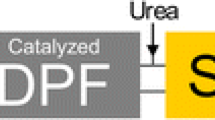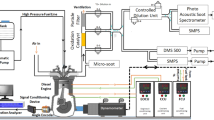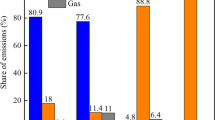Abstract
Diesel particulate matter (PM) has been associated with adverse health effects in humans and is classified as a human carcinogen. Additionally, the strongly light absorbing fraction, black carbon (BC), has been identified as an important climate forcer. For these reasons, the effectiveness of aftermarket controls on reducing PM and BC from three stationary diesel gensets (230, 400, and 600 kW) of varying engine displacement (from 8.8 to 27 L) and physical size was investigated. Uncontrolled emissions were compared with emissions controlled with a passive (P-DPF) and active diesel particulate filter (A-DPF) and a diesel oxidation catalyst (DOC). Overall, the DPFs resulted in significant PM mass removal (~80–99 %), while the DOC resulted in statistically insignificant reductions (~0–25 %). Both BC and elemental carbon (EC) removal followed a similar trend, but EC/PM ratios varied from 0 to 0.79 over all test conditions, indicating changes in PM composition with the addition of aftermarket controls or changes in load. Further, the single scattering albedo of PM was slightly decreased from the DPFs compared to the uncontrolled case. Particle number concentrations were also significantly reduced when using DPFs, with a greater than 97 % reduction in particle concentrations with the P-DPF and greater than 82 % reduction with the A-DPF. The DOC exhibited much lower particle reductions, reducing the particle concentration by only 5–35 %, depending upon the genset or load. These results demonstrate that while DPFs are effective at reducing PM and BC emissions, the particle characteristics are altered from those of uncontrolled emissions.


Similar content being viewed by others
Notes
40 CFR part 89 and 40 CFR part 1039. Control of Emissions from New and In-Use Nonroad Compression Ignition Engines
40 CFR part 63, subpart ZZZZ. National Emissions Standards for Hazardous Air Pollutants for Stationary Reciprocating Internal Combustion Engines (RICE)
References
Allansson R, Maloney C, Walker A, Warren J (2000) Sulphate production over the CRT™: What fuel sulphur level is required to enable the EU 4 and EU 5 PM standards to be met? SAE Technical Paper 2000-01-1875
Arnott WP, Hamasha K, Moosmüller H, Sheridan PJ, Ogren JA (2005) Towards aerosol light-absorption measurements with a 7-wavelength Aethalometer: evaluation with a photoacoustic instrument and 3-wavelength nephelometer. Aerosol Sci Technol 39(1):17–29. doi:10.1080/027868290901972
Bauner D, Laestadius S, Iida N (2009) Evolving technological systems for diesel engine emission control: balancing GHG and local emissions. Clean Technol Environ Policy 11:339–365. doi:10.1007/s10098-008-0151-x
Bond TC, Doherty SJ, Fahey DW, Forster PM, Berntsen T, DeAngelo BJ et al (2013) Bounding the role of black carbon in the climate system: a scientific assessment. J Geophys Res Atmos 118(11):5380–5552. doi:10.1002/jgrd.50171
Brito JM, Belotti L, Toledo AC, Antonangelo L, Silva FS, Alvim DS et al (2010) Acute cardiovascular and inflammatory toxicity induced by inhalation of diesel and biodiesel exhaust particles. Toxicol Sci 116(1):67–78. doi:10.1093/toxsci/kfq107
Chow JC, Watson JG, Doraiswamy P, Chen L-WA, Sodeman DA, Lowenthal DH et al (2009) Aerosol light absorption, black carbon, and elemental carbon at the Fresno Supersite California. Atmos Res 93(4):874–887. doi:10.1016/j.atmosres.2009.04.010
Dallman TR, DeMartini SJ, Kirchstetter TW, Herndon SC, Onasch TB, Wood EC, Harley RA (2012) On-road measurement of gas and particle phase pollutant emission factors for individual heavy-duty diesel trucks. Environ Sci Technol 46(15):8511–8518. doi:10.1021/es301936c
Eldering A, Cass GR (1996) Source-oriented model for air pollutant effects on visibility. J Geophys Res. doi:10.1029/95JD02928
Flowers BA, Dubey MK, Mazzoleni C, Stone EA, Schauer JJ, Kim S-W, Yoon SC (2010) Optical-chemical-microphysical relationships and closure studies for mixed carbonaceous aerosols observed at Jeju Island; 3-laser photoacoustic spectrometer, particle sizing, and filter analysis. Atmos Chem Phys 10:10387–10398. doi:10.5194/acp-10-10387-2010
Fontaras G, Franco V, Dilara P, Martini G, Manfredi U (2014) Development and review of Euro 5 passenger car emission factors based on experimental results over various driving cycles. Sci Total Environ. doi:10.1016/j.scitotenv.2013.09.043
Fujita EM, Campbell DE, Arnott WP, Chow JC, Zielinska B (2007) Evaluations of the chemical mass balance method for determining contributions of gasoline and diesel exhaust to ambient carbonaceous aerosols. JAPCA J Air Waste Manag 57(6):721–740. doi:10.3155/1047-3289.57.6.721
Hansen ADA, Rosen H, Novakov SM (1984) The Aethalometer—an instrument for the real-time measurement of optical absorption by aerosol particles. Sci Total Environ 36:191
International Agency for Research on Cancer (IARC) (2012) Diesel engine exhaust carcinogenic, Media Release, IARC and World Health Organization (WHO), Lyon, France: 12 June
Jacobson MZ (2002) Control of fossil-fuel particulate black carbon and organic matter, possibly the most effective method of slowing global warming. J Geophys Res 107(D19):4410. doi:10.1029/2001JD001376
Khalek IS, Kittelson DB, Graskow BR, Wei Q, Brear F (1998) Diesel exhaust particle size: Measurement issues and trends. SAE Technical Paper, 980525
Khalek IA, Bougher TL, Merritt PM, Zielinska B (2011) Regulated and unregulated emissions from highway heavy-duty diesel engines complying with U.S. Environmental Protection Agency 2007 emissions standards. JAPCA J Air Waste Manag 61(4):427–442. doi:10.3155/1047-3289.61.4.427
Khan B, Hays MD, Geron C, Jetter J (2012) Differences in the OC/EC ratios that characterize ambient and source aerosols due to thermal-optical analysis. Aerosol Sci Technol 46(2):127–137. doi:10.1080/02786826.2011.609194
Kittelson DB (1998) Engines and nanoparticles : a review. J Aerosol Sci 29(5):575–588
Kittelson DB, Watts WF, Johnson JP, Remerowki ML, Ische EE, Oberdörster G et al (2004) On-road exposure to highway aerosols. 1 Aerosol and gas measurements. Inhal Toxicol 1(16 Suppl):31–39. doi:10.1080/08958370490443024
Konstandopoulos AG (2000) Fundamental studies of diesel particulate filters: Transient loading, regeneration and aging. SAE Technical Paper 2000-01-1016
Lack DA, Cappa CD (2010) Impact of brown and clear carbon on light absorption enhancement, single scatter albedo and absorption wavelength dependence of black carbon. Atmos Chem Phys 10(9):4207–4220. doi:10.5194/acp-10-4207-2010
Lee D, Miller A, Kittelson D, Zachariah MR (2006) Characterization of metal-bearing diesel nanoparticles using single-particle mass spectrometry. J Aerosol Sci 37(1):88–110. doi:10.1016/j.jaerosci.2005.04.006
Liu ZG, Ford DC, Vasys VN, Chen D-R, Johnson TR (2007) Influence of engine operating conditions on diesel particulate matter emissions in relation to transient and steady-state conditions. Environ Sci Technol 41(13):4593–4599. doi:10.1021/es0616229
Mayer A, Egli H, Burtscher H, Czerwinski J, et al (1995) Particle size distribution downstream traps of different design, SAE Technical Paper 950373
Mayer A, Czerwinski J, Scheidegger P (1996) Trapping efficiency depending on particulate size, SAE Technical Paper 960472
Nash DG, Swanson NB, Preston WT, Yelverton TLB, Roberts WL, Wendt JOL, Linak WP (2013) Environmental implications of iron fuel borne catalysts and their effects on diesel particulate formation and composition. J Aerosol Sci 58:50–61. doi:10.1016/j.jaerosci.2013.01.001
Park SS, Hansen ADA, Cho SY (2010) Measurement of real time black carbon for investigating spot loading effects of Aethalometer data. Atmos Environ 44(11):1449–1455. doi:10.1016/j.atmosenv.2010.01.025
Pope CA, Dockery DW (2006) Health effects of fine particulate air pollution: lines that connect. JAPCA J Air Waste Manag 56(6):709–742. doi:10.1080/10473289.2006.10464485
Ramanathan V, Carmichael G (2008) Global and regional climate changes due to black carbon. Nat Geo Sci 1:221–227. doi:10.1038/ngeo156
Reşitoğlu IA, Altinisik K, Keskin A (2014) The pollutant emissions from diesel-engine vehicles and exhaust aftertreatment systems. Clean Technol Environ Policy. doi:10.1007/s10098-014-0793-9
Ryan NE, Larsen KM, Black PC (2002) Smaller, closer, dirtier: Diesel backup generators in California. Environmental Defense Report: New York
Schnaiter M, Horvath H, Mohler O, Naumann KH, Saathoff H, Schock OW (2003) UV-vis-NIR spectral optical properties of soot and soot-containing aerosols. J Aerosol Sci 34(10):1421–1444. doi:10.1016/S0021-8502(03)00361-6
Shah SD, Cocker DR, Miller JW, Norbeck JM (2004) Emission rates of particulate matter and elemental and organic carbon from in-use diesel engines. Environ Sci Technol 38(9):2544–2550. doi:10.1021/es0350583
Shah SD, Cocker DR, Johnson KC, Lee JM, Soriano BL, Miller JW (2007) Reduction of particulate matter emissions from diesel backup generators equipped with four different exhaust aftertreatment devices. Environ Sci Technol 41(14):5070–5076. doi:10.1021/es0614161
Strawa AW, Kirchstetter TW, Hallar AG, Ban-Weiss GA, McLaughlin JP, Harley RA, Lunden MM (2010) Optical and physical properties of primary on-road vehicle particle emissions and their implications for climate change. J Aerosol Sci 41(1):36–50. doi:10.1016/j.jaerosci.2009.08.010
Subramanian R, Winijkul E, Bond TC, Thiansathit W, Oanh NTK, Paw-armart I, Duleep KG (2009) Climate-relevant properties of diesel particulate emissions: results from a piggyback study in Bangkok Thailand. Environ Sci Technol 43(11):4213–4218. doi:10.1021/es8032296
U.S. DOE. (2000) Diesel Emission Control Sulfur Effects (DECSE) Program - Phase I Interim Data Report No. 4: Diesel Particulate Filters—Final Report January 2000
U.S. Environmental Protection Agency (2010). Diesel oxidation catalyst general information EPA Technical Bulletin420-F-10-031. http://www.epa.gov/cleandiesel/documents/420f10031.pdf. Accessed 11 Dec 2014
Virkkula A, Mäkelä T, Hillamo R, Yli-Tuomi T, Hirsikko A, Hämeri K, Koponen IK (2007) A Simple Procedure for Correcting Loading Effects of Aethalometer Data. JAPCA J Air Waste Manag 57(10):1214–1222. doi:10.3155/1047-3289.57.10.1214
Wang SC, Flagan RC (1990) Scanning electrical mobility spectrometer. Aerosol Sci Technol 13:230–240. doi:10.1080/02786829008959441
Wien S, England GC, Chang OMC (2004) Development of fine particulate emission factors and speciation profiles for oil and gas-fired combustion systems, topical report: test results for a diesel fuel-fired compression ignition reciprocating engine with a diesel particulate filter at site Foxtrot
Acknowledgments
The authors are grateful to Carl Singer (ARCADIS International) for aiding in system design and data reduction, Daniel Janek (ARCADIS International) for genset operation and data collection, Melanie King (U.S. EPA) for regulatory guidance and support, and the members of Manufacturers of Emission Controls Association (MECA) for use of PM control devices for testing. The research described in this article has been reviewed by the U.S. EPA National Risk Management Research Laboratory and approved for publication. The contents of this article should not be construed to represent Agency policy nor does mention of trade names or commercial products constitute endorsement or recommendation for use.
Author information
Authors and Affiliations
Corresponding author
Additional information
Jelica Pavlovic was a ORISE postdoctoral fellow at the U.S. Environmental Protection Agency Research Triangle Park, NC at the time the research and analysis were completed.
Electronic supplementary material
Below is the link to the electronic supplementary material.
Rights and permissions
About this article
Cite this article
Yelverton, T.L.B., Holder, A.L. & Pavlovic, J. Emissions removal efficiency from diesel gensets using aftermarket PM controls. Clean Techn Environ Policy 17, 1861–1871 (2015). https://doi.org/10.1007/s10098-015-0900-6
Received:
Accepted:
Published:
Issue Date:
DOI: https://doi.org/10.1007/s10098-015-0900-6




